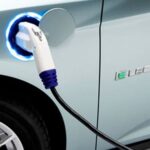Slide 1. Introduction.
The class develops the fire safety regulations for electric vehicle batteries, and the implications for fleet management.
Slide 2. Safety regulations for electric vehicle batteries.
- Chinese battery fire regulations.
Battery fire is the most dangerous thing in electric vehicles, and safety measures must be taken to prevent and avoid it.
China's GB 38031-2020 standard, implemented in early 2021, sets the standard for the global industry in electric vehicle overheating safety. It was the first mandatory standard to set a 5-minute warning for occupants to escape from the vehicle.
China's Ministry of Industry and Information Technology (MIIT) has established a new mandatory safety regulation popularly known as 'No Fire, No Explosion', stricter than before, which will come into force in July 2026.
The Chinese electric vehicle market is increasingly dominated by LFP- Lithium Phosphate or LiFePO₄ chemistry, which makes meeting this challenge easier than with the more energy-dense NMC- Nickel-Manganese-Cobalt chemistries. But it is still not straightforward, as no energy storage system is 100% safe by nature.
When China announced the 2020 standard, automakers largely adapted existing battery platforms to meet the new standard. This time around, automakers have taken fire safety into account much earlier in the design process and have tried to go beyond the 5-minute warning.
However, China's new requirement is a major hurdle because, although it is possible to avoid overheating between cells and there are several material options, as always, a balance has to be struck between the performance and price of each battery design. All of this comes at a time when reducing the cost of batteries is critical to the future adoption of electric vehicles.
What is clear is that Chinese standards are moving much faster when it comes to overheating in electric vehicles than other regions.
- China: GB38031-2025 standard.
The new GB38031-2025 Safety Requirements for Electric Vehicle Batteries was announced on March 28, 2025.
Its entry into force, however, will not be effective until July 1, 2026, a decision taken to give manufacturers time to develop compliant batteries.
This is the first safety regulation in the world that requires batteries to be capable of preventing fires and explosions.
Compared to the previous regulation, the most important change is that the new thermal diffusion test is introduced. Until July 1, 2026, the standard only required a warning signal to sound five minutes before a fire or explosion was about to occur. With the new regulation, batteries are required not to catch fire or explode under any circumstances, even during a thermal runaway, and the smoke produced must not harm the occupants of the vehicle.
In addition, the tests to which they are subjected are stricter, as two new tests are added, according to the Chinese government's website.
1.The first is a lower impact test, which seeks to evaluate the protection capacity of the battery when this part suffers a collision.
2.The second consists of safety tests in fast charge cycles, being necessary that the batteries neither catch fire nor explode during 300 cycles nor in the subsequent short-circuit tests.
The standard also adds internal heating as a test trigger mechanism, along with external heating and piercing. If overheating does not occur with one of these test methods, the others should be tested.
- CATL batteries.
CATL, the world's largest battery manufacturer, is more than a year ahead of the new Chinese safety regulation GB38031-2025 coming into effect.
Although the margin to adapt to the new regulation is wide, CATL has already got the go-ahead for its Qilin battery, with the report being issued by the China Automotive Technology and Research Center (CATARC), an external certification agency.
On April 29, 2025, it officially announced having officially become the first company to comply with the new standard. A relevant aspect is that the Quilin was launched almost three years ago, in July 2022, which employs the third generation of the brand's cell-to-package CTP technology and is a good example of the company's safety standards.
This is noteworthy since in February 2025, CATL announced that there were already 18 million electric cars in the world using its batteries and that, specifically, the Qilin is present in models of a large number of brands, such as Aito, Avatr, Li Auto, Xiaomi, Neta or Zeekr, Volvo and Lotus, three brands belonging to the Geely group. Mercedes, Stellantis and BMW are also on CATL's customer list.
Launched in June 2022 and in series production from 2023, the Qilin battery embodies the third generation of CTP technology. It has an energy density of 255 Wh/kg and a usage efficiency of 72 %. According to CATL, this performance makes it possible to design electric vehicles capable of achieving a range of 1,000 kilometers according to the Chinese CLTC cycle, unashamedly more optimistic than the European WLTP.
Qilin cells incorporate an innovative cooling system: functional elements are now inserted between adjacent cells, quadrupling the heat transfer surface, while improving the compactness of the battery pack.
As a result, the battery can be recharged from 10% to 80% in just 10 minutes, at a rate of 5 C. Recall that the C rate of a battery is the measure of current at which a battery is charged and discharged. A 1 C rate is equivalent to 60 minutes, 0.5 C to 120 minutes and 2 C to 30 minutes. CATL is already talking about a future generation capable of 6C. Very interesting figures, given that charging speed is now becoming a more crucial criterion than autonomy.
- Europe: UNECE R100 standard.
Europe is awaiting the UNECE R100 standard and its amendments. The R100-05 version will come into force for new vehicle types in September 2027 and for all new vehicle types in September 2029. This is a significant delay from China's implementation in 2026, and the requirements are much more similar to the Chinese 2020 standard.
A 5-minute warning to vehicle occupants after a thermal event, during which no hazardous situation for occupants such as fire, smoke or explosion can occur.
The latest updates appear to be more specific in terms of the testing mechanisms, rather than the final safety outcome.
- United States: UNECE Standards.
Although the United States also relies on UNECE standards, the NHTSA-National Highway Traffic Safety Administration, is the key safety enforcement agency. Its latest revision of FMVSS 305a closely follows the UNECE regulations, but has adopted a less stringent safety standard. In this case, it is not required to detect single-cell overheating, but is based entirely on the temperature inside the package.
While GTR20 calls for a 5-minute warning between the onset of single-cell overheating and danger to occupants, NHTSA argues that single-cell detection would be "an excessive design constraint, and would not be relevant under all conditions.
Instead of a warning that is triggered by the failure of a single cell, NHTSA proposes a warning system that is triggered when the temperature within the battery system significantly exceeds the maximum operating temperature. To test this system, the battery must be opened and a heater that reaches 600°C within 30 seconds must be connected to the cells so that at least one cell goes into thermal runaway. The warning should occur within 3 minutes of heater startup.
- Fleet management implications.
These measures are expected to ensure greater safety with respect to possible fires in electric vehicles.
A vehicle in Europe or the United States, in order to be marketed, must comply with the European or the United States battery fire standards, but if it also complies with the new 38031-2025 China standard, which has more safety requirements, its use has more benefits and advantages.
It is necessary to purchase vehicles with the highest possible battery fire safety measures, so before purchasing the vehicle, it is necessary to find out which fire safety standard the battery complies with.
Or find out which vehicles meet the new 38031-2025 China standard, such as CATL's Qilin battery, are available in our country.
The information can be found in the technical information of the vehicle, you can ask the vehicle or battery manufacturer directly or search on the Internet.
The new safety measures may increase the cost of batteries and electric vehicles, but safety must always be given priority.
Electric vehicles that comply with the new GB38031-2025 China standard have a competitive advantage, so it is expected that in time it will become the standard for electric vehicles, and that most battery manufacturers will manufacture it.
These safety standards are updated over time with the addition of new safety measures, so you should be aware of these updates and incorporate them into your fleet vehicles as they are acquired.
Slide 3. Thank you for your time.
The class has developed the fire safety regulations for electric vehicle batteries, and the implications for fleet management, see you soon.
Download the audio




















